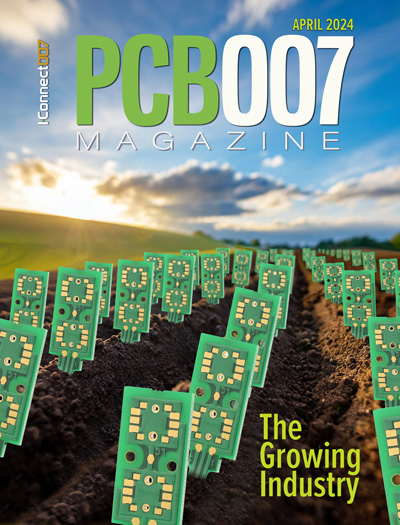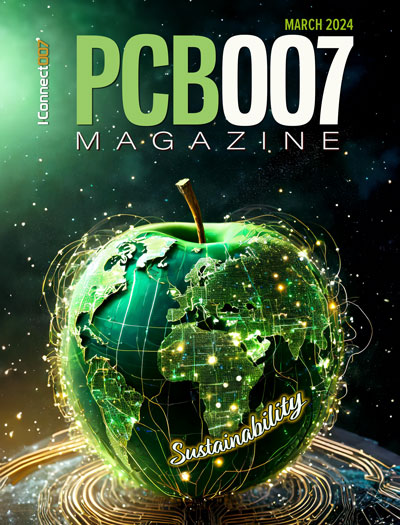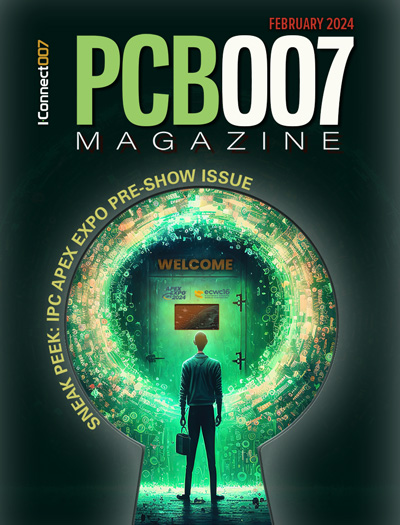-

- News
- Books
Featured Books
- pcb007 Magazine
Latest Issues
Current Issue
The Growing Industry
In this issue of PCB007 Magazine, we talk with leading economic experts, advocacy specialists in Washington, D.C., and PCB company leadership to get a well-rounded picture of what’s happening in the industry today. Don’t miss it.

The Sustainability Issue
Sustainability is one of the most widely used terms in business today, especially for electronics and manufacturing but what does it mean to you? We explore the environmental, business, and economic impacts.

The Fabricator’s Guide to IPC APEX EXPO
This issue previews many of the important events taking place at this year's show and highlights some changes and opportunities. So, buckle up. We are counting down to IPC APEX EXPO 2024.
- Articles
Article Highlights
- Columns
Search Console
- Links
- Events
||| MENU - pcb007 Magazine
First EIE and CCI Eurolam on Direct Imaging, Printers and Partnership
January 25, 2016 | Barry Matties, I-Connect007Estimated reading time: 14 minutes
When the right equipment manufacturers find the right distributors, everyone wins—especially customers. I was able to meet with two such companies at productronica 2015 for an in-depth discussion. In this interview, Gregory Stoeckli, CEO of First EIE, shares the realities of direct imaging requirements, while Lawson Lightfoot of CCI Eurolam discusses the success of the new distribution partnership the two companies have formed. Something we all agreed upon: A somewhat slower machine that is both highly flexible and affordable is a great fit for high-mix, low-volume producers.
Barry Matties: Gregory, please start by describing the relationship between First EIE and CCI Eurolam.
Gregory Stoeckli: First EIE is an equipment manufacturing company and we design, develop and produce equipment. CCI Eurolam is our newly appointed distributor for Europe. We changed at the beginning of 2015 and I’m extremely impressed to see the amount of quality business we have had at productronica. The whole CCI team put in a lot of effort to make this happen.
Matties: That’s excellent. Congratulations.
Stoeckli: I’m very happy about this new partnership. It’s not like selling a car—you need to understand what the customers’ needs are. You need to understand the wet process, starting from the copper preparation, lamination and exposure. So someone coming from the consumable field, knowing exactly what the customer needs and what they want, can sell our equipment and processes more effectively. But once you have sold it, you need to provide support. It’s a strong match.
Matties: Lawson, you’re providing the after-sales support as well?
Lawson Lightfoot: We are providing sales support initially and with First EIE’s existing engineering resource, the after-sales technical support. Most of the people within CCI Eurolam are not just salespeople, but have a strong technical background. In fact, we tend to come from a PCB background and are very production-oriented. We have been involved both directly and indirectly in manufacturing boards ourselves for many years. Many of us have also come from other supply houses as well, which helps in providing an overall knowledge of the PCB manufacturing process. There is a wide range of skills within the whole group. CCI Eurolam has a presence in more than 48 countries in Europe and North Africa so we are able to provide both excellent sales penetration and the aftersales support to accompany this.
Matties: Gregory, please describe your product lineup for our readers.
Stoeckli: First EIE has been well-known for our photoplotters for almost 30 years. In fact, we started in the PCB industry with photoplotters, with a variety of products, from the small RP200 up to the very big RP800, whereas the RP700, with 50,000 dpi, is our flagship product. We just recently we got the order for a very big machine—1 meter 60 by 2 meter 40. This is a great achievement. It’s not for PCBs, but for the touch panel industry in Korea.
First EIE is very well-established worldwide, with a strong position in Europe as well as Asia, from Japan to Taiwan, including South Korea, China, and obviously the other ASEAN countries. To serve our customers, we have provided continuous improvement and development in our photoplotter because the demands are evolving.
Of course, we also have the inkjet printer that does the legend ink. It’s interesting to see that we are always among the top three players. We have something designed for production. This is a big difference from when we started 12 years ago, when the engineers designed a great piece of “engineered” equipment, but too complicated for production.
The CP562 is the third generation of equipment which was optimized for production. This means that on Monday you switch it on, and you can print. Everything is made automatically for maintenance; it surveys that the ink is always the right temperature. We have several of these machines in the field working with good success.Page 1 of 3
Suggested Items
Taiyo Circuit Automation Installs New DP3500 into Fuba Printed Circuits, Tunisia
04/25/2024 | Taiyo Circuit AutomationTaiyo Circuit Automation is proud to be partnered with Fuba Printed Circuits, Tunisia part of the OneTech Group of companies, a leading printed circuit board manufacturer based out of Bizerte, Tunisia, on their first installation of Taiyo Circuit Automation DP3500 coater.
Vicor Power Orders Hentec Industries/RPS Automation Pulsar Solderability Testing System
04/24/2024 | Hentec Industries/RPS AutomationHentec Industries/RPS Automation, a leading manufacturer of selective soldering, lead tinning and solderability test equipment, is pleased to announce that Vicor Power has finalized the purchase of a Pulsar solderability testing system.
AIM Solder’s Dillon Zhu to Present on Ultraminiature Soldering at SMTA China East
04/22/2024 | AIMAIM Solder, a leading global manufacturer of solder assembly materials for the electronics industry, is pleased to announce that Dillon Zhu will present on the topic: Ultraminiature Soldering: Techniques, Technologies, and Standards at SMTA China East. This event is being held at the Shanghai World Expo Exhibition & Convention Center from April 24-25.
AIM to Highlight NC259FPA Ultrafine No Clean Solder Paste at SMTA Wisconsin Expo & Tech Forum
04/18/2024 | AIMAIM Solder, a leading global manufacturer of solder assembly materials for the electronics industry, is pleased to announce its participation in the upcoming SMTA Wisconsin Expo & Tech Forum taking place on May 7 at the Four Points by Sheraton | Milwaukee Airport, in Milwaukee, Wisconsin.
Hentec/RPS Publishes an Essential Guide to Selective Soldering Processing Tech Paper
04/17/2024 | Hentec Industries/RPS AutomationHentec Industries/RPS Automation, a leading manufacturer of selective soldering, lead tinning and solderability test equipment, announces that it has published a technical paper describing the critical process parameters that need to be optimized to ensure optimal results and guarantee the utmost in end-product quality.


